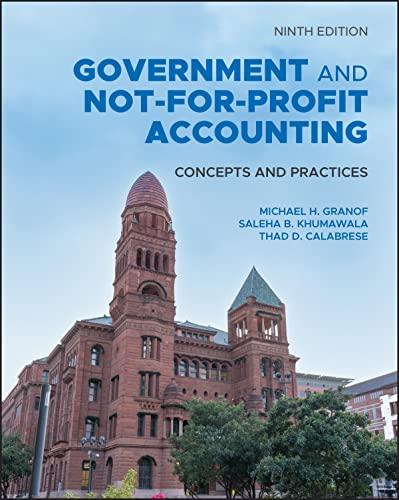During 20Xl Luling Township engaged in the following transactions related to modernizing the bridge over the Luling
Question:
During 20Xl Luling Township engaged in the following transactions related to modernizing the bridge over the Luling River. The township accounts for long-term construction projects in a capital projects fund.
• On July 1 it issued 10-year, 4 percent bonds with a face value of $1 million. The bonds were sold for $1,016,510, an amount that provides an annual yield of 3.8 percent
(semiannual rate of 1.9 percent). The city incurred $10,000 in issue costs.
• On August 1, it was awarded a state reimbursement grant of $800,000. During the year it incurred allowable costs of $600,000 . Of these it paid $500,000 in cash to various contractors. It received $450,000 from the state, expecting to receive, early in 20X2, the $150,000 difference between allowable costs incurred and cash received. Moreover, it expects to receive the balance of the grant later in 20X2.
• It invested the bond proceeds in short-term federal securities. During the year it received $8,000 in interest, and at year-end the fair value of the securities was $1,000 more than the township had paid for them.
• It transferred the bond premium (net of issue costs) to an appropriate fund.
• It transferred $20,000 from the general fund to an appropriate fund to cover the first payment of bond interest that was due, and paid, on December 31.
• On January 1, the township defeased in substance $400,000 of bonds that had been issued years earlier to construct the bridge . The bonds had been issued at par.
To effect the transaction the township issued $405,000 of new bonds, at par, and placed the proceeds in a trust. The old bonds have a coupon rate of 5 percent; the new bonds have a coupon rate of 4 percent.
What a mount should Luling report in its December 31, 20Xl, financial statements as:
1. Nonreciprocal transfers-in to its debt service fund
2. Interest expenditure in its debt service fund
3. Interest expense on its government-wide statements (after taking into account amortization of the bond premium)
4 . Investment revenue in its capital projects fund
5 . Bonds payable in its capital projects fund
6. Total expenditures in its capital projects fund
7. Bond proceeds in its capital projects fund
8 . Bond proceeds in its debt service fund
9. Deferred outflow of resource s ( lo ss on defeasance) in its debt service fund
10. Grant revenue in its capital projects fund
11. Grants receivable in its capital projects fund
12. Carrying value of bonds payable ( on issue of July 1 only) in its government-wide statements Select each response from the amounts that follow.
An amount may be selected once, more than once, or not at all.
a . $0
b. $8,000
c. $9,000
d. $16,510
e. $19,314
f. $20,000
g. $26,510
h. $38,627
i. $150,000
j. $200,000
k. $400,000
l. $405,000
m . $500,000
n. $600,000
o. $610,000
p. $1,0 00,000
q. $1,0 06 ,510
r. $1 ,016 ,510
s . $1,015,824
Step by Step Answer:

Government And Not For Profit Accounting Concepts And Practices
ISBN: 9781119803898
9th Edition
Authors: Michael H. Granof, Saleha B. Khumawala, Thad D. Calabrese





